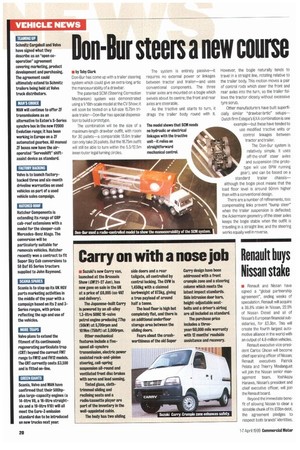Don-Bur steers a new course
Page 22

If you've noticed an error in this article please click here to report it so we can fix it.
• by Toby Clark Don-Bur has come up with a trailer steering system which could give an extra-long artic the manoeuvrability of a drawbar.
The patented SCM (Steering Correction Mechanism) system was demonstrated using a 1/16th-scale model at the CV Show: it will soon be tested on a full-size 15.75m triaxle trailer—Don-Bur has special dispensation to build a prototype.
The combination will be the size of a maximum-length drawbar outfit, with room for 30 pallets—a comparable 13.6m trailer can only take 26 pallets. But the18.75m outfit will still be able to turn within the 5.3/12.5m inner/outer legal turning circles. The system is entirely passive—it requires no external power or linkages between tractor and trailer—and uses conventional components. The three trailer axles are mounted on a bogie which swivels about its centre; the front and rear axles are steerable.
As the tractive unit starts to turn, it drags the trailer body round with it. However, the bogie naturally tends to travel in a straight line, rotating relative to the trailer body. This motion moves a pair of control rods which steer the front and rear axles into the turn, so the trailer follows the tractor closely without excessive tyre scrub.
Other manufacturers have built superficially similar "drawbar/artic" setups— Dutch firm Estepe's EXA combination is one example—but these have tended to use modified tractive units or control linkages between tractor and trailer.
The Don-Bur system is relatively simple. It uses off-the-shelf steer axles and suspension (the prototype will use BPW running gear), and can be based on a standard trailer chassis— although the bogie pivot means that the load floor level is around 50mm higher than with a conventional design.
There are a number of refinements, too: compensating links prevent "bump steer" when the trailer suspension is deflected; the Ackermann geometry of the steer axles keeps the bogie stable when the outfit is travelling in a straight line; and the steering works equally well in reverse.




































































































